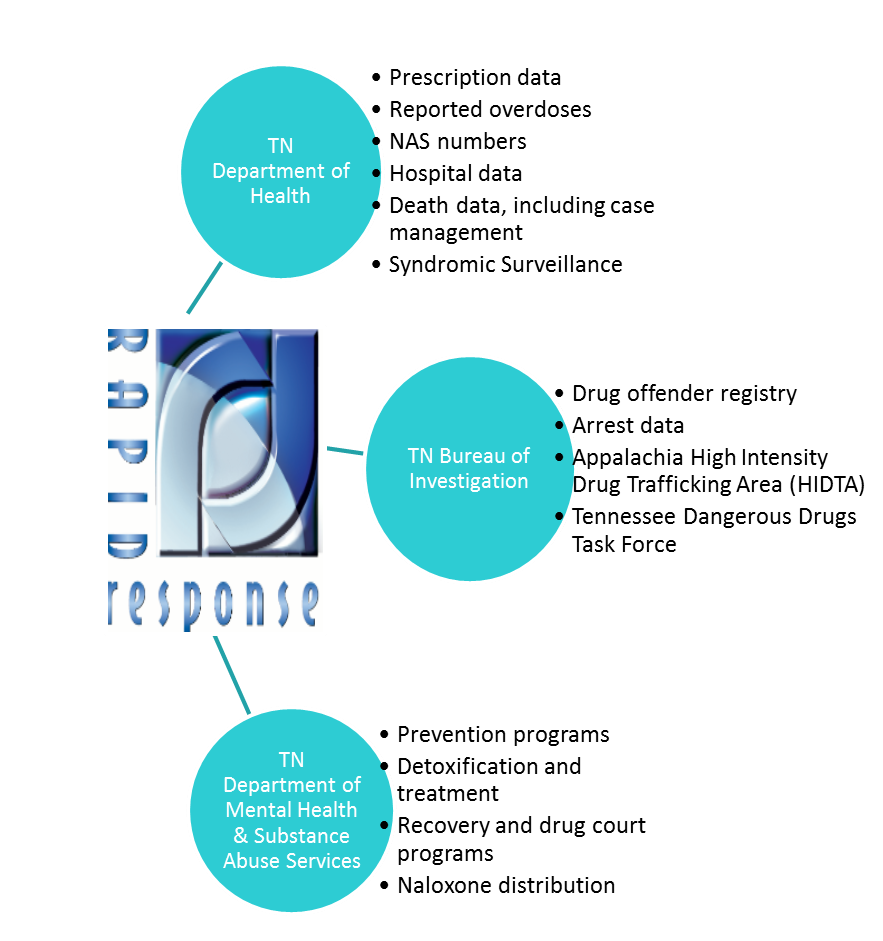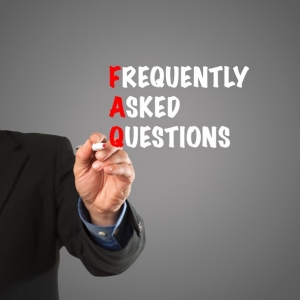Who We Are

The Advanced Analytics and Visualization (AAV) unit within the Office of Informatics and Analytics (OIA) has a robust data and analytic infrastructure for several projects and programs that support the Tennessee Department of Health, including analytics focusing on drug overdose and prescription use and abuse in Tennessee. AAV has expertise in producing timely, reliable, and high-quality analyses and data visualizations. The unit has developed expertise on the translation and dissemination of data to broad audiences, including the creation of infographics that have been used across content areas to capture the impact of health conditions. OIA AAV values innovation and data agility—whether for enhanced data analytics and creating dynamic visualizations, or for exploring newly emerging techniques in the fields of data science and biostatistics.
Contact us: TDH.Analytics@tn.gov

Tennessee REDLINE
If you or someone you know is in need of referral services have them call the Tennessee REDLINE.
The Tennessee REDLINE (1-800-889-9789) is a toll-free information and referral line coordinated by the Tennessee Association of Alcohol, Drug and other Addiction Services (TAADAS) and funded by the Tennessee Department of Mental Health Substance Abuse Services (TDMHSAS). The purpose of the TN REDLINE is to provide accurate, up-to-date alcohol, drug, gambling problems, and other addiction information and referrals to all citizens of Tennessee at their request. The REDLINE provides referrals for Co-Occurring Alcohol & Drug disorders that arise along with Mental Health disorders.
Information specialists are on duty 24 hours a day, 7 days a week to answer questions and provide information and referrals on alcohol, tobacco, other drugs and gambling. https://www.taadas.org/our-programs-and-services/redline
Grants
Overdose Data to Action
Overdose Data to Action is a 3-year cooperative agreement that began in September 2019 and focuses on the complex and changing nature of the drug overdose epidemic and highlights the need for an interdisciplinary, comprehensive, and cohesive public health approach. Funds awarded as part of this agreement will support state, territorial, county, and city health departments in obtaining high quality, more comprehensive, and timelier data on overdose morbidity and mortality and using those data to inform prevention and response efforts.
Using data to better understand
Recipients will be able to do a number of surveillance activities to monitor and gather data about the scope and nature of the overdose problem under the new cooperative agreement:Collect and disseminate emergency department data on suspected overdoses categorized as “all drug,” “all opioid,” “heroin,” and “all stimulant.”Collect and disseminate descriptions of drug overdose death circumstances using death certificates, toxicology reports, and medical examiner/coroner reports.Implement innovative surveillance activities to support interventions. These activities help increase comprehensiveness of surveillance data and allow jurisdictions to tailor their surveillance efforts to specific needs. The data dashboards can be found HERE.
Harold “Hal” Rogers Prescription Drug Monitoring Program: Data-Driven Responses to Prescription Drug Abuse
The Tennessee Department of Health was awarded the Harold “Hal” Rogers Prescription Drug Monitoring Program: Data-Driven Responses to Prescription Drug Abuse Grant in September 2016 by the Office of Justice Programs under the US Department of Justice. The primary purpose of the Harold Rogers Prescription Drug Monitoring Program (PDMP) is to enhance the capacity of regulatory and law enforcement agencies and public health officials to work together to collect and analyze controlled substance prescription data and other scheduled chemical products through a centralized database administered by an authorized state agency. Through this grant the Tennessee Department of Health is enhancing the existing collaboration between the health department (Tennessee Department of Health), law enforcement (Tennessee Bureau of Investigation [TBI]) and substance abuse services (Tennessee Department of Mental Health and Substance Abuse Services [TDMHSAS]) to better understand the progression from drug use to drug abuse to drug addiction in the state of Tennessee. This grant will also give the team the ability to pool resources and identify abuse trends and “hot spots” of activity within the state. By utilizing data sources and sharing key data from all three organizations, and collaborating with community coalitions, we will be able to target our efforts to areas of need with a focused rapid response team. This team will be able to connect with individuals who are at risk of diverting prescription drugs or transitioning to illicit drugs and recommend or deliver treatment. With the information provided to the team they will be able to focus their efforts on where interventions are most necessary.

Controlled Substance Monitoring Database (CSMD)
In accordance with the Controlled Substance Monitoring Act of 2002, the Tennessee Department of Health established a database to monitor the dispensing of Schedule II, III, IV & V controlled substances. Data collection began for all dispensers on December 1, 2006. The Prescription Safety Act of 2012 enhances the monitoring capabilities of the database. The Board of Pharmacy and the Controlled Substance Monitoring Database (CSMD) Committee establish, administer, maintain and direct the functioning of the database in accordance with these statutes.
You will find additional information regarding the CSMD by following this link https://www.tn.gov/health/health-program-areas/health-professional-boards/csmd-board/csmd-board/about.html

FAQ
- What is an opioid?
Opioids are a broad range of natural and manufactured (synthetic) drugs that are commonly used for pain relief. - What kind of drugs are opioids?
Opiods are a class of drugs that include the illegal drug heroin as well as powerful pain relievers available legally by prescription, such as oxycodone (OxyContin®), hydrocodone (Vicodin®), codeine, morphine, fentanyl, and many others. - What form(s) do opioids come in?
Opioids come in tablets, capsules or liquid. - What are three main groups of opioid drugs:
Naturally occurring: These are made from the liquid harvested from the unripe seed pods of the opium poppy flower. Examples include codeine and morphine.
Semi-synthetic: These are made by modifying the chemical structure of a naturally occurring opioid. Examples include heroin and oxycodone.
Synthetic: These compounds are manufactured chemicals. Examples include meperidine and methadone. - What are some common opioid?
Generic Name |
Brand Name |
Fentanyl |
Duragesic |
Hydrocodone |
Norco, Vicodin |
Hydromorphone |
Dilaudid, Exalgo |
Morphine |
Astramorph, Avinza |
Oxycodone |
OxyContin,Percocet |
6. How are opioid medications regulated?
Opioids are regulated at both federal and state levels. You can find more detailed information at these locations: https://www.fda.gov/downloads/aboutfda/centersoffices/officeofmedicalproductsandtobacco/cder/ucm550079.pdf
https://bup.clinicalencounters.com/
7. What should I do with leftover/unwanted prescription pills?
FDA supports the responsible disposal of medicines from the home. Almost all medicines can be safely disposed of by using medicine take-back programs or using U.S. Drug Enforcement Agency (DEA)-authorized collectors. When these options are not available, consumers may also dispose of unneeded medicine in their household trash
Unwanted Pharmaceutical Take Back Map for TN: http://tdeconline.tn.gov/rxtakeback/
Source: https://www.fda.gov/drugs/ensuring-safe-use-medicine/safe-disposal-medicines
Medicines recommended for flushing down the toilet: https://www.fda.gov/downloads/Drugs/ResourcesForYou/Consumers/BuyingUsingMedicineSafely/EnsuringSafeUseofMedicine/SafeDisposalofMedicines/UCM337803.pdf
8. What are the signs of drug abuse?
Changes in behavior: changes in sleeping and eating habits, up-and-down moods, sneaky behavior, relationships that are getting worse
Physical signs of abuse/dependence: red eyes, sore throat, and a dry cough; needle marks on the arm of other area of body; small ‘pinpoint’ pupils in the eyes; losing weight without trying; hallucinations.
9. Opioid overdose
Due to their effect on the part of the brain which regulates breathing, opioids in high doses can cause respiratory depression and death. An opioid overdose can be identified by a combination of three signs and symptoms referred to as the “opioid overdose triad”. The symptoms of the triad are:
- pinpoint pupils
- unconsciousness
- respiratory depression
10. How can I avoid opioid overdose?
Take medicine only if it has been prescribed to you by your doctor. Do not take more medicine or take it more often than instructed. Call a doctor if your pain gets worse. Never mix pain medicines with alcohol, sleeping pills, or any illicit substances. Store your medicine in a safe place where children or pets can’t reach it. Learn the signs of overdose and how to use naloxone to keep it from becoming fatal. Teach your family and friends how to respond to an overdose. Dispose of unused medicine properly.
11. Drug Overdose
A drug overdose is the accidental or intentional use of a drug or medicine in an amount that is higher than is normally used.
12. What is Naloxone?
The drug naloxone is sometimes called a “save shot” or a “rescue shot” due to its ability to bring someone back from an overdose. Brand names for naloxone are Narcan and Evzio.
Contact Us
If you have any questions or comments you would like to share, click on the link below to enter your information in the Office of Informatics and Analytics (OIA) Comments, Questions and Feedback form. All information shared will remain confidential. You may also contact us directly at TDH.Analytics@tn.gov.